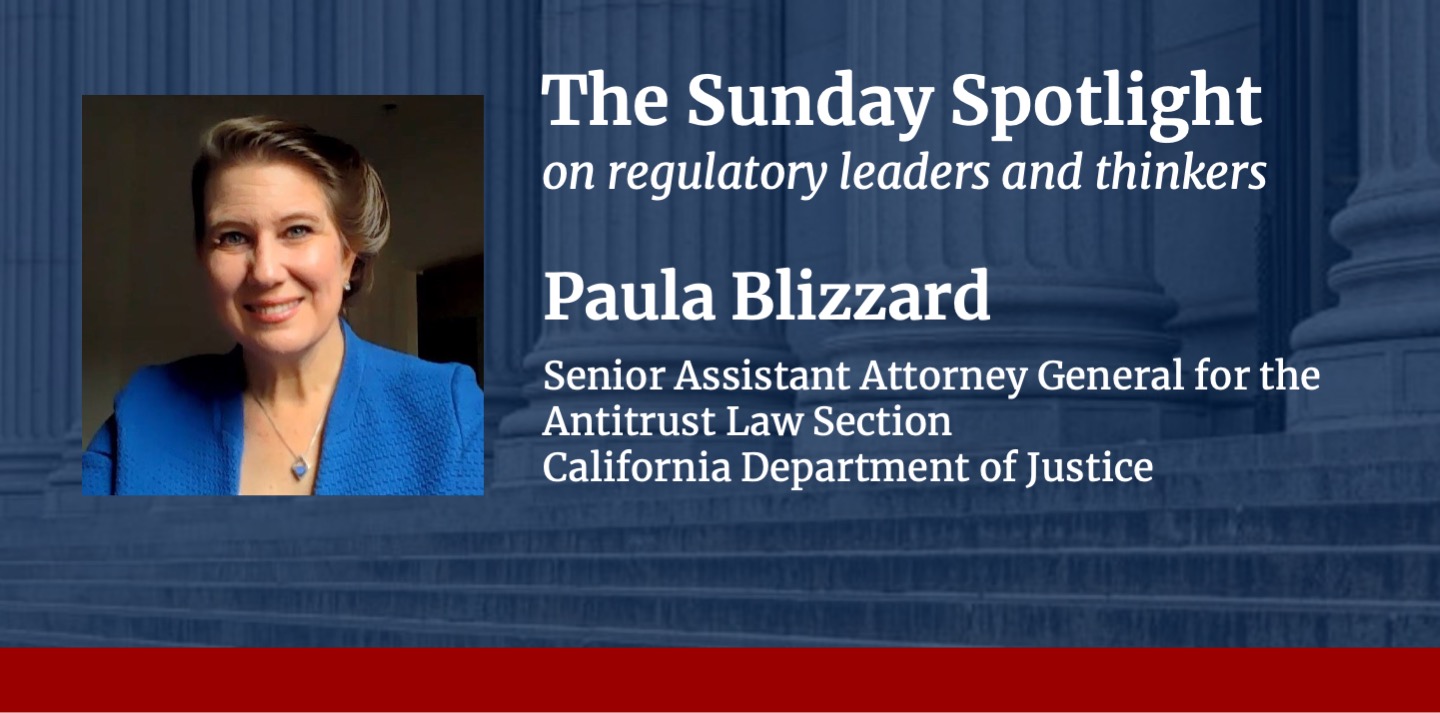
Paula Blizzard discusses the California Department of Justice’s leadership in antitrust enforcement.
In a conversation with The Regulatory Review, Paula Blizzard discusses the enduring role of state antitrust enforcement, the unique features of California’s competition laws, and the impact of new technologies on the future of antitrust enforcement.
Antitrust enforcement has captured public attention in recent years, with high-profile lawsuits spanning industries such as housing, technology, and transportation. Although the U.S. Department of Justice’s Antitrust Division and Federal Trade Commission earn many headlines, practitioners have noted an increased role for state antitrust enforcers in the United States. As Blizzard explains, however, state involvement in antitrust is not new. She notes that state competition statutes predate the Sherman Act—the 1890 federal law that prohibits activities that restrict competition—and states have long played a central role in enforcing these laws.
Blizzard points to an example dating over two decades ago, when California led a coalition of states in United States v. Microsoft Corporation. The U.S. Justice Department and the states alleged that Microsoft had illegally attempted to monopolize the web browser market. California refused to settle on the terms of the U.S. Justice Department’s court-approved settlement—known as a consent decree—instead pursuing additional litigation against Microsoft.
Blizzard also considers emerging developments in antitrust, including algorithmic pricing and conduct driven by artificial intelligence, and previews the trends likely to shape state antitrust enforcement over the next five years. These developments, she notes, likely align with the “breadth and adaptability” of antitrust laws, which have already managed to address industries that did not exist when many antitrust laws were enacted.
Paula Blizzard is the senior assistant attorney general for the Antitrust Law Section of the California Department of Justice. Before becoming California’s top antitrust enforcer, Blizzard served as the deputy bureau chief of the Federal Communications Commission’s Enforcement Bureau. She also served as a trial attorney at the U.S. Justice Department, where she was special counsel for the enforcement of the Microsoft consent decree.
The Regulatory Review is pleased to share the following interview with Paula Blizzard.
The Regulatory Review: What role have states historically played in antitrust?
Blizzard: State competition laws predate the 1890 Sherman Act. The states were some of the most ardent and active enforcers of the Sherman Act when it was first passed, and the states have continued that pattern up until today, albeit with some ups and downs. But nothing that is happening today is new. Sometimes states agree with the federal enforcers, and sometimes they do not. Remember 25 years ago when a group of states, led by California, broke off from the U.S. Justice Department’s Microsoft consent decree to go to trial over the monopolization remedies? In recent years, antitrust enforcement has increased at both the federal and state levels, and I think that is the trend you are seeing.
TRR: In what ways do California’s competition laws, the Cartwright Act and the Unfair Competition Act (UCL), create opportunities or challenges compared to federal antitrust law?
Blizzard: California’s state competition laws provide many opportunities for robust antitrust enforcement. At the same time, they have some limits that the federal laws do not have. The Cartwright Act has been described by the California Supreme Court as being “broader in range and deeper in reach than the Sherman Act,” yet it does not cover monopolization. Nor does it cover mergers. However, the UCL is broader than federal antitrust laws generally. The UCL’s unfair prong is “intentionally framed in its broad, sweeping language, precisely to enable judicial tribunals to deal with the innumerable new schemes which the fertility of man’s invention would contrive,” as a federal appeals court recently explained.
TRR: How do California’s competition laws compare to other states’ competition laws?
This is a hard one because state laws vary a great deal. Other states have monopolization statutes, merger statutes, specialized statutes for specific industries, and a wide variety of unfair and deceptive practices statutes that are sometimes used in competition matters. And they are changing all the time because generally state competition laws are revised and modified much more frequently than the federal antitrust laws. I would say generally that our UCL is one of the broader statutes and one of the most useful in terms of addressing conduct that does not quite fit the mold of a typical antitrust violation.
TRR: When California partners with the federal government or other states’ attorneys general in major antitrust cases, how do you structure collaboration, particularly around discovery strategy and managing different jurisdictions’ priorities?
We work very collaboratively with other state and federal enforcers all the time. Each case is a little bit different and tailored to the specific facts and claims at issue. In the Google search monopolization cases, for example, a group of states—including California—are co-plaintiffs with the U.S. Justice Department, while another group of states filed a separate complaint that was consolidated with the U.S. Justice Department complaint for discovery and trial. In another case, against Live Nation Entertainment and Ticketmaster, the U.S. Justice Department is seeking injunctive relief, whereas the states are additionally seeking damages, restitution, and penalties. At the end of the day, each sovereign entity is a plaintiff in its own right and can seek discovery and relief as it sees fit. But we try to cooperate as best we can, because a court is not going to appreciate any parties—be they plaintiffs or defendants—that are not able to resolve most discovery matters without court intervention.
TRR: Artificial intelligence dominates the news cycle, raising concerns about algorithmic pricing and further consolidation in the technology sector. Are there any legislative reforms in California necessary to strengthen antitrust enforcement given the rapid development of this technology?
Blizzard: Breadth and adaptability to new industries are existing strengths of the antitrust laws. The basic constructs of many competition laws—prohibitions against unfair practices and contracts, combinations, or conspiracies in restraint of trade—have been around for hundreds of years. Those laws were written before the widespread use of electricity, cars, airplanes, telephones, motion pictures or the internet. But they still worked to address all those industries. As a California appeals court has explained, California’s UCL already covers unfair practices that “may run the gamut of human ingenuity and chicanery.” That being said, the California legislature is very active in this area, and I look forward to seeing what ends up being enacted into law.
TRR: What trends do you see developing in state antitrust law over the next five years?
I think both federal and state enforcement will continue to be on an upswing. There are high levels of concentration in many industries, high levels of corporate power, and a big income disparity between those who profit from the stock market and those who do not. California looks forward to participating in this trend and increasing the strength of its economy for the benefit of its citizens.



